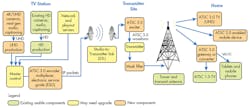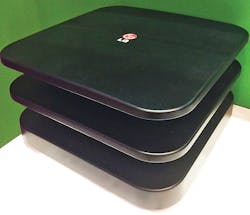Download this article as a .PDF
The first Advanced Television Standards Committee (ATSC) standard for over-the-air (OTA) digital television broadcast (ATSC 1.0) was approved by the FCC in 1996. That was seven years after the World Wide Web was created, when only 0.04% of the world’s population had internet access and cellular technology was in its second generation. It’s obviously time for a change, and the new ATSC 3.0 provides just that—and then some. In fact, ATSC 3.0 is so much more advanced and comprehensive than its predecessor, it effectively makes OTA a true competitor to cable, fiber, satellite, and internet streaming for the first time.
With the vast majority of people receiving programming via cable, fiber, or subscription video-on-demand (SVOD) services like Netflix, Amazon, and Hulu, OTA probably seems archaic. However, the usage of OTA has actually increased about 4% per year in the last two years, mostly the result of cord-cutters supplementing their SVOD service with local content. The remainder of OTA users are mostly either people who cannot afford broadband or cable, are happy with they get over the air, or simply don’t watch TV. ATSC 3.0 should increase penetration even further, as it has some unique benefits.
Finalization of ATSC 3.0 effectively relegates ATSC 2.0 to telecom history—even Wikipedia devotes a paltry 73 words to the topic. The reason for the leapfrog from “1.0” to “3.0” is that even though ATSC 2.0 exists as a standard with full documentation, by the time it was finalized it was clear to the ATSC that additional capabilities would be required to keep OTA relevant in the future. Most of the features within ATSC 2.0 were “ported over” to ATSC 3.0, which is more comprehensive, requiring 20 standards and more than 1,000 pages of documentation.
ATSC 3.0 should serve the broadcast industry for a very long time, as it includes features previously available only via cable, fiber, or internet streaming, as well as some that aren’t available from any other source. To provide such features, while also allowing the standard to accommodate enhancements in the future, ATSC 3.0 (unlike ATSC 2.0) is not backward-compatible with current ATSC 1.0 tuners.
To receive OTA channels, consumers will need new TVs, dedicated streaming boxes, external tuners, or a new type of appliance called a home gateway. The need to replace existing equipment was a major concern as the standard was being developed. Thus, last November, the FCC ordered broadcasters choosing to begin voluntary ATSC 3.0 transmission to simulcast ATSC 1.0 signals so that OTA viewers could retain service. The ATSC 1.0 simulcasts must offer similar programming to ATSC 3.0 channels for five years.
Based on the current pace of ATSC 3.0 rollouts, ATSC 3.0-enabled equipment, from TVs to home gateways and other ATSC 3.0 enablers, will be available a lot sooner than five years. In fact, at the Consumer Electronics Show (CES) in January—where with much fanfare the “ribbon cutting” for ATSC 3.0 formally took place—ATSC 3.0-capable TVs were announced by almost every manufacturer.
The drive to accelerate the pace was driven primarily by the South Korean government and its major manufacturers. LG Electronics introduced the world’s first ATSC 3.0-capable 4K TV for the Korean market early last year with Samsung following shortly thereafter. The service is already available in Seoul and some other areas of the country from its leading terrestrial broadcasters, and the entire country should be covered by 2021. The 2018 Winter Olympics in PyeongChang are showcasing the country’s accomplishments, as multiple events were broadcast OTA in 4K.
In the U.S., the ATSC 3.0 rollout will take longer. However, it probably will not take as long as projected, as it is not the complete paradigm shift that 2009’s analog-to-digital transition was. Sinclair Broadcast Group, the largest TV station operator in the U.S., and Korea’s SK Telecom have signed a pact to build an ATSC 3.0 platform before this July.
The platform, called NG TV platform (for next generation), will deliver 4K content, customized IP-based interactive services, personalized and location-based advertising, fixed and mobile broadcast service, and emergency alerting. Sinclair’s deployments and others should help speed the release of 4K content, which is currently mostly the domain of Blu-ray players, satellite providers DIRECTV and Dish, as well as Netflix, Amazon, and Comcast.
What’s Inside ATSC 3.0
ATSC 3.0 is an IP-based technology that combines OTA signals (i.e., received from an antenna) with supplementary content delivered via broadband, thereby making it a hybrid system (Fig. 1). The result is a combination of the interactive capabilities of streaming with the low cost of “one-to-many” OTA broadcast and the high image and audio quality of cable or satellite TV.
1. The ATSC 3.0 broadcast system as envisioned by the NAB shows the ability to use some existing broadcast equipment along with the new equipment that will be required. (Source: NAB)
The ability to integrate internet-delivered content with that from OTA paves the way for finely-targeted advertising and two-way interactive services, as well as authenticated, tiered broadcast services. ATSC 3.0 supports legacy SD video resolutions up to 720 × 480, interlaced HD video resolutions up to 1920 × 1,080, and progressive-scan video with resolution up to 3,840 × 2,160 and frame rates up to 120 fps, as well as digital watermarking of the audio signal and video signal.
In addition, ATSC 3.0 enables the long-awaited overhaul of the Emergency Alert System (EAS) via an Advanced Warning and Response Network (AWARN). Rather than a simple alert, it can deliver photos, surveillance video, storm tracks, evacuation routes, shelter instructions, hospital wait times, power outage locations, and other information. It can also “wake up” devices that are not powered on to deliver alerts.
Although TVs will soon be ATSC 3.0-compatible, the home gateway is also appealing. It performs multiple functions, combining OTA and internet-delivered content and sending it to a Wi-Fi router to stream devices throughout the home. As indoor reception is projected to be much better than with ATSC 1.0, many areas won’t require an outdoor antenna. Instead, the antenna will be part of the home gateway. Greater signal strength is achieved by adaptable frequency capability that lets signals travel further and penetrate deeper into buildings and other RF-constrained places.
LG Electronics has been showing such a device called an “ATSC 3.0 Smart Antenna” at CES for the last three years (Fig. 2). The module employs an electronically-steerable directional antenna and is very small, allowing it to be placed almost anywhere in a home. It integrates an ATSC 3.0 tuner-demodulator system-on-a-chip (SoC) and ATSC 1.0 analog tuner for backward compatibility. The National Association of Broadcasters (NAB) has developed its own gateway architecture through its PILOT initiative that has similar capabilities.
2. The LG Electronics ATSC 3.0 Smart Antenna combines the ability to receive OTA broadcast using an electronically-steerable antenna with an Ethernet interface to broadband to provide over-the-top content. An ATSC 1.0 tuner allows for backward compatibility. The combined signals are connected to a Wi-Fi router for distribution throughout a home. (Source: LG Electronics)
Key Technologies
When the ATSC 1.0 standard was developed, it was based on the analog TV formula in which every channel was allocated 6 MHz of spectrum. This was enough bandwidth to deliver digital video at 19.39 Mb/s and to accommodate two HDTV and three SDTV channels. Now, in this same 6-MHz channel, ATSC 3.0 uses a more spectrally-efficient H.265 HEVC, (High Efficiency Video Coding) video compression technique rather than MPEG-2 used in ATSC 1.0. This makes it possible to transmit more video content with less data—it delivers 4K video in half the bandwidth of ATSC 1.0.
ATSC 3.0 also has better audio compression via Dolby AC-4 rather than the current Dolby AC-3 and supports viewing on ATSC-3.0-capable mobile devices as well as enhanced video capabilities from 3D to high dynamic range (HDR), high frame rate (HFR), and wide color gamut (WCG) technology currently available only via wired and satellite solutions. ATSC 3.0’s mobile television support is enabled by its more robust signals, and the broadcast and automotive industries are working with developers to create an alternative to cellular-based delivery of everything from telematics and infotainment to diagnostics and emergency alerting (Fig. 3).
3. ATSC 3.0 enhances the concept of a digital dashboard by delivering audio, 4K video, text alerts, and other features to vehicle infotainment systems. (Source: NAB)
Coming Soon(er)
ATSC, NAB, and the broadcast industry have been working on upgrading the current standard for years. More than 12,000 patents have been issued to U.S., Korean, Japanese, and European companies. Although full deployment of ATSC 3.0 in the U.S. is still several years away, consumers considering upgrading to a 4K TV might be wise to delay that decision, as the benefits of ATSC 3.0 seem to be worth waiting for. It’s likely that smartphones will incorporate it in the next two years, as well as vehicles. In short, OTA might seem as archaic as “rabbit ears,” but the new standard not only rejuvenates it, but makes it both a complement to existing delivery systems and a new competitor as well.




